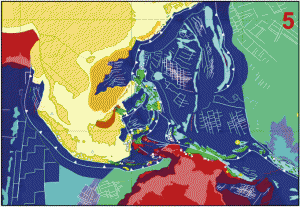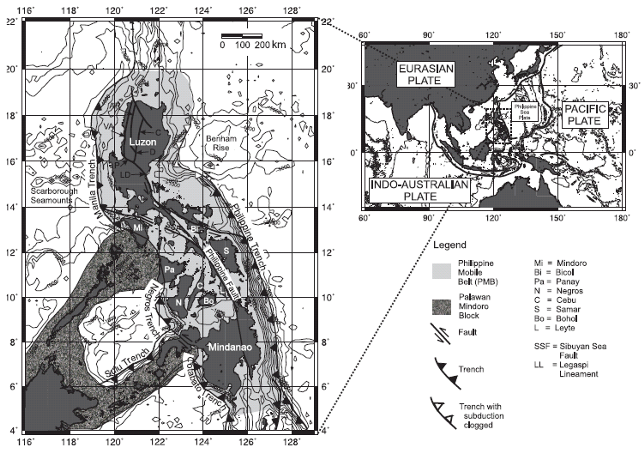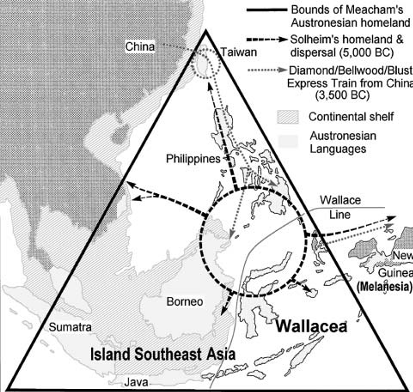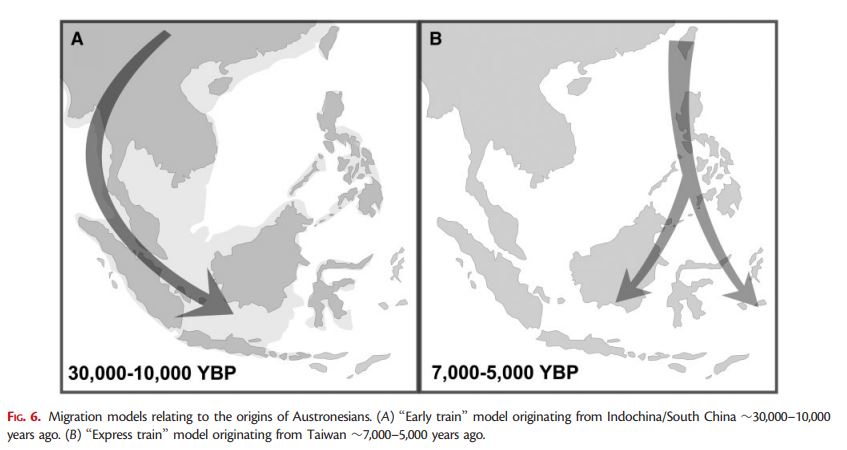The peopling of the Philippines: theories, literature, evidence
Contents
General theory on the geological emergence of the Philippine islands
There are actually several theories on how the various geological (including tectonic and climatic) forces resulted in the emergence and shaping of the Philippine islands, as well as the time scales involved. These theories agree on some key aspects and conflict on others. For detailed explanation about particular theories and their ramifications, see: Geological development of the Philippine islands.
In general terms, however, currently there is just one comprehensive scientific theory that organizes much of the available geological evidence into one integrated whole. This theory is based on plate tectonics.
Fundamental role of plate tectonics
On vast time scales of millions of years, it is now well-established that tectonic plate movements shaped much of the geological structure that created and now underlies the Philippines. The plate tectonic reconstructions of SEARG [1] show these movements in an animated visual way that is easily understood by most people.
Most geological experts are now agreed that the structure underlying the bulk of the country -- the Philippine Mobile Belt (PMB) sometimes simply called the Philippine Plate -- was created by the gradual convergence of the Philippine Sea Plate (itself just the western margin of the much bigger Pacific Plate domain) to the east, the Eurasian Plate (particularly its Sunda Block) to the west, and the Indo-Australian Plate to the south.
Effect of other geological forces
On relatively shorter time scales of a million years or less, tectonic plate movements have a less dramatic impact on the configuration of the emergent archipelago. Meanwhile, on such scales, volcanism, subsidence and uplifting, and major climate changes continue to reshape particular island arcs, "land bridges", and mountain ranges whether now submerged or above sea level.
In that context, the continued movement and reshaping of the Philippine land forms on finer scales, vis-a-vis the Eurasian land mass and neighboring island arcs, have greatly affected the pattern of how the country was eventually populated by our hominin (proto-human and later fully human) ancestors after the first founding populations arrived and settled the land.
Various theories on the peopling of the Philippines have been proposed, elaborated, and criticized accordingly.
Sources
- SEARG Plate Tectonic Reconstructions – Models
- New Definition of Philippine Plate Boundaries and Implications to the Philippine Mobile Belt
- Philippine Sea and East Asian plate tectonics since 52 Ma constrained by new subducted slab reconstruction methods
- Timing and tectonic controls in the evolving orogen of SE Asia and the western Pacific and some implications for ore generation
Theories on the peopling of the Philippines
Arrival or emergence of early hominin (pre-Austronesian) populations
- Prevailing theories on the earliest peopling of Southeast Asia
- Homo-related artifacts in Kalinga ca. 700 Kya
- Homo luzonensis and related discoveries in archaeological sites (Callao, Tabon)
Austronesian migrations theory
- Bellwood and Blust's "out of Taiwan" (aka "express train") theory of Austronesian migrations
- Oppenheimer's "out of Wallacea" (aka "slow boat") theory of Austronesian migrations
- Solheim's Nusantao variation: Pre-Austronesian origins somewhere in Indochina, spread to Island Southeast Asia and further development into Austronesian.
- Basic archaeological, linguistic and other evidence and related arguments in support of either theory
Figure. Map showing two main alternative views of Austronesian origins, on-shore and off-shore. The oldest view represented by Meacham (solid triangle), Terrell and Solheim (interrupted solid black line and circle) argues an Island Southeast Asian homeland (>5,000 BCE). The ‘out of Taiwan’ view of a recent rapid migration from China via Taiwan (3,000–4,000 BC), spreading to replace the older populations of Indonesia after 2,000 BC, is shown as a finer dotted line. (Source: Oppenheimer 2003.)
Figure. Simplified map showing the general routes of "two major waves of Austronesian migration"
Earlier theories
- Otley H. Beyer's "three or four migration waves" (also known as "multiple homelands") theory
- F. Landa Jocano's "core population" theory
Literature on prehistoric and pre-Hispanic periods
- F. Landa Jocano. 1975. Philippine Prehistory: An Anthropological Overview of the Beginnings of Filipino Society and Culture.
- William Henry Scott. 1984. Prehispanic Source Materials for the Study of Philippine History.
- William Henry Scott. 1994. Barangay: Sixteenth-Century Philippine Culture and Society.
- Elisabeth A. Bacus. Later prehistory of the Philippines: colonial images and archaeology
Evidence from archaeology, genomics, and linguistics
Notes
On pre-Austronesian hominins
- Prehistory of Southeast Asia. 2008. International seminar on the oldest Human settlements in Eurasia
- Graeme Barker and Martin B. Richards. 2012. Foraging–Farming Transitions in Island Southeast Asia
- Timothy A. Jinam, Lih-Chun Hong et al. 2012. Evolutionary History of Continental Southeast Asians: “Early Train” Hypothesis Based on Genetic Analysis of Mitochondrial and Autosomal DNA Data
- Roy Larick and Russell L. Ciochon. 2015. Early Hominin Biogeography in Island Southeast Asia
- Christopher J. Bae, Katerina Douka, and Michael D. Petraglia. 2017. Human Colonization of Asia in the Late Pleistocene
- Lipson, Cheronet et al. 2018. Ancient genomes document multiple waves of migration in Southeast Asian prehistory
- Hsiao-chun Hung. 2019. History and Current Debates of Archaeology in Island Southeast Asia
On the Austronesians
- Stephen Oppenheimer. 2003. Austronesian spread into Southeast Asia and Oceania:where from and when?
- Peter Bellwood, James J. Fox, Darrell Tryon (eds). 2006. The Austronesians: Historical and Comparative Perspectives
- Peter Bellwood and Eusebio Dizon. 2008. Austronesian cultural origins: Out of Taiwan, via the Batanes Islands, and onwards to Western Polynesia.
- David R. Thomas. 2011. Origins of the Austronesian Peoples
- Nala Huiying Lee. 2012. Multidisciplinary Perspectives on the Austronesian Homeland: A Critique
- Soares, Trejaut et al. 2015. Resolving the ancestry of Austronesian‑speaking populations. 2015.
- Jean-Christophe Gaillard and Joel P. Mallari. The peopling of the Philippines: A cartographic synthesis



